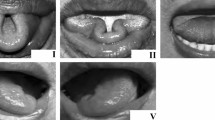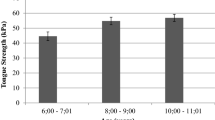Abstract
The study sample consisting of 429 people (207 males, 222 females) of Han nationality in Shaanxi, China. Five types of tongue movements were investigated, including tongue rolling, tongue folding, tongue twisting, pointed tongue and clover-leaf tongue. The results revealed that the frequencies of tongue rolling, tongue folding, tongue twisting, pointed tongue and clover-leaf tongue were 63.6, 14.0, 12.6, 54.8 and 0 %, respectively. There were no significant gender differences except with pointed tongue. Compared with other nationalities, tongue rolling, tongue folding, and pointed tongue of Han in Shaanxi had an average frequency. Tongue twisting and clover-leaf tongue had low frequencies. There were significant differences in frequency of clover-leaf tongue between Han and another seven nationalities of China (P < 0.01). Furthermore, only three pairs of trait correlations were exhibited among ten pairs of types of tongue movement combination traits when analyzed using Pearson’s correlation coefficient. The data indicated that the correlations of tongue movement were between tongue rolling and tongue folding, between pointed tongue and tongue rolling, and also between tongue folding and pointed tongue, respectively. Additionally, there were significant differences in frequency of tongue movements with age. The possible mechanism of variations of tongue movements with aging may involve the degradation of tongue function, and differential gene activation and modulation, or protein translation.
Similar content being viewed by others
Avoid common mistakes on your manuscript.
Introduction
The tongue is the primary muscular organ of deglutition, taste and speech. Human beings have extrinsic and intrinsic muscles of the tongue. Both sets of muscles are innervated by the hypoglossal nerve and the vagus nerve. Under coordination of extrinsic muscles in the tongue, contraction or relaxation of the intrinsic muscles can produce some special types of tongue movement, including tongue rolling, tongue folding, tongue twisting, pointed tongue and clover-leaf tongue. The special types of tongue movement are important classic indicators in human population genetics. Few researches on tongue movement have been conducted previously (Hoch 1949; Whitney 1950; Bat-Miriam 1962). The ability to turn up the edges of the tongue (tongue upfolding/tongue folding) is conditioned at least in part by heredity, and the dominant gene is responsible for folding and rolling of the lateral edges of the tongue while the inability to roll and fold the tongue is associated with the recessive gene (Sturtevant 1940; Hsu 1948). Some other results revealed that the hereditary mode of pointed tongue is the dominant heredity of a single autosomal gene, and tongue twisting is the recessive heredity of a single autosomal gene (Li et al. 2003). No significant difference in gender distribution of tongue rolling or tongue folding was found in an African population (Odokuma et al. 2008). However, few data on traits of tongue movements exist in the Han Chinese population.
Shaanxi Province is located in north-western China, in the middle reaches of the Yellow River, between 31°42′–39°35′N latitude and 105°29′–110°15′E longitude (Fig. 1). The total area of Shaanxi is 205,800 km2 and the population was 37.33 million in 2010. Shaanxi Province is one of the birthplaces of Chinese primitive human beings and national culture. All in all, Shaanxi plays an important role in the existence and development of the Chinese nation as well as in human history. Xi’an, one of the oldest cities in China with more than 3,100 years of history, is the capital of t Shaanxi province. In the present study, we investigate the traits of five tongue movements in a sample of the Chinese Han population of Xi’an, Shaanxi.
Subjects and methods
Subjects
A total of 429 persons of Han nationality in Xi’an, Shaanxi province, aged ≥20 years participated in the surveys, which were carried out in 2010. All subjects joined this study voluntarily and provided informed consent. The sample size of age groups of each survey is given in Table 1. All subjects came from unrelated families and each individual was traced back through more than three generations of family history in Xi’an, to ensure their national representativeness of the Xi’an Han population. All subjects had a thorough medical examination before the investigation. They were all in apparently good health, free from overt disease or deformity.
Methods
The assessment of five tongue movements was described previously (Li et al. 2003; Liu and Hsu 1949). The investigation was done after each subjects showed that they understood an initial explanation of each of the five tongue movements. For the study of combinations of tongue movements, the following types of movement were recorded: ability to roll, fold, twist, and to be pointed, clover-leaf tongue, and inability to roll, fold, twist, and to be pointed, clover-leaf tongue. The five types of tongue movement are briefly depicted as follows (supplementary Fig. S1):
-
1.
Tongue rolling: the tongue curls upward on both sides and is tube-like; this is known as tongue rolling (R); otherwise, it is non-tongue rolling (NR).
-
2.
Tongue folding: the tip of the tongue goes upward and backward to return to fold with the lingual surface to form tongue folding (F), otherwise, it is called non-tongue folding (NF).
-
3.
Tongue twisting: the right side rim of tongue goes upward, the glossal left side rim goes down at the same time and the tongue flips 90° or more, in the form of erect tongue-turning right, and this is called right tongue twisting. The left side rim of tongue goes upward, the glossal right side rim goes down at the same time and the tongue flips 90° or more, in the form of erect tongue-turning left, and this is called left tongue twisting. The tongue can twist both ways for full tongue twisting, and twist only one way for tongue twisting (T). A tongue that cannot twist either way is known as the non-twisting tongue type (NT).
-
4.
Pointed tongue: both sides of the tongue contract and the tongue stretches forward and protrudes, the tip of tongue also thickens, narrows, and sharpens (P); otherwise, it is called non-pointed tongue (NP).
-
5.
Clover-leaf tongue: the tongue is in the mouth, the tongue front-end elevates, the tongue on both sides can retract, and the entire edges of the tongue are clover-shaped, and this is called clover-leaf tongue type (C); otherwise, it is called non-clover-leaf tongue (NC).
Statistical analysis
Chi-square (χ2) was used to test for variations in frequency of the five types of tongue movement between females and males. The U test was applied to compare the frequencies of the five types of tongue movement between Han and another seven Chinese nationalities. Pearson χ2 was used to test for variations at different ages. Pearson’s correlation coefficient was used to identify the correlation of the tongue movements to each other. All data are expressed as mean ± standard error (SE), and P < 0.05 was considered statistically significant. All statistical analyses were performed with SPSS 13.0 statistical analysis software.
Results
Table 2 shows the frequency of the five types of tongue movement of people of Han nationality in Shaanxi, China. There were no significant gender differences (P > 0.05) except for pointed tongue (P < 0.01). The frequency of tongue rolling was more common than non-tongue rolling. The frequencies of non-tongue folding, non-tongue twisting and the non-clover-leaf tongue were more common than those of tongue folding, tongue twisting and clover-leaf tongue, respectively. However, the frequency of pointed tongue was higher than that of non-pointed tongue in females, but lower in males.
Table 3 compares the frequency of five types of tongue movement between Han and another seven Chinese nationalities (U test). There were significant differences in the frequency of clover-leaf tongue between Han and the other seven nationalities (P < 0.01). There were significant differences in frequency of pointed tongue between Han and the other seven nationalities, except Man. The frequency of tongue rolling was at the middle level compared with other nationalities. There were significant differences in frequency of tongue rolling between Han and Man, Mongolian, Hui, and Korean nationalities, respectively. A higher percentage of Man was observed to exhibit tongue folding than Han, and a lower percentage of Wa, Dong, Mongolian and Hui were observed to exhibit tongue folding than Han. These differences were statistically significant. There were no significant differences in frequency of tongue folding between Han and Korean and between Han and Miao. There were significant differences in the frequency of tongue twisting between Han and the other seven nationalities, except Wa.
The five types of tongue movement in people of different ages were compared by Pearson χ2. The results are shown in Tables 4, 5, 6, and 7. There were significant differences between 20–29 years old and 50–59 years old in the frequency of the five types of tongue movements except clover-leaf tongue. There were distinct differences between 20–29 years old and ≥60 years old, 30–39 years old and 50–59 years old, 30–39 years old and ≥60 years old, 40–49 years old and ≥60 years old in the frequency of the five types of tongue movements except tongue rolling and clover-leaf tongue. There were also significant differences between 30–39 years old and 50–59 years old in frequency of tongue folding and pointed tongue.
Pearson’s correlation coefficient was employed to explore the correlation of the tongue movements to each other. The results were shown in Table 8. The prominent correlations were between tongue folding and tongue rolling, pointed tongue and tongue rolling, tongue folding and pointed tongue. There were no correlations among the remainder combination traits.
Discussion
The frequency of clover-leaf tongue was zero, and the frequency of tongue rolling was the highest (63.6 %) among five tongue movements of Han nationality in Shaanxi. The result of the frequency of clover-leaf tongue was related to the sample size limitation and needs further elucidation. Pentzos-Daponte (1986) reported that significant sex differences concerned only tongue rolling. There was a significant difference only in the frequency of pointed tongue between male and female in the present study. These results are inconsistent with previous reports (Liu and Hsu 1949; Pentzos-Daponte 1986), but were similar to those of Zheng et al. (1997).
The Han nationality is the most numerous as well as the most widely spread in China. There were distinct differences in frequency of tongue movements between Han and other nationalities in China. A high frequency of variety of tongue movements was found in other nationalities. These results suggest that a genetic element plays an important role in the frequency of tongue movements. There were dominant nationality differences.
In this study, the variations in tongue movements are different ages were investigated. There were significant differences in the frequency of tongue movements with age. Our results indicate that aging may lead to functional deficit or impairment in muscle movement of the tongue. The possible mechanism may involve degradation of tongue function, and differential gene activation and modulation, or protein translation, etc. The mechanism of variations of tongue movements with aging needs further study in future.
Analysis of the correlation of five tongue movements among ten combination traits was done with Pearson’s correlation coefficient. Only three pairs exhibit trait correlation of types of tongue movement among ten pairs of combination traits. These results suggest that only few correlations of the five tongue movements in the Han nationality. An earlier report showed five pairs of trait correlations among ten pairs in the Daur nationality of Inner Mongolia (Li et al. 1999), and four pairs of trait correlations among six pairs in Han, Mongolian, and Hui nationalities of Inner Mongolia (Zheng et al. 1997). These findings indicate differences in correlation in different nationalities and regions. Furthermore, the findings of the present study indicate a prominent correlation between tongue folding and tongue rolling, pointed tongue and tongue rolling, tongue folding and pointed tongue. There were no correlations among the remaining seven combination traits. These data suggest that gene interactions might occur between the tongue rolling gene and the tongue folding gene, and also between the pointed tongue gene and tongue rolling gene, and the tongue folding gene and pointed tongue gene, respectively. These gene interactions among tongue movements will require further study.
Five types of tongue movement are classic genetic indicators of physical anthropology. The above results reflect the genetic characteristics of the Chinese Han. It is important to explore the variation in tongue movements with age and Han adult physical variation in order to complete the physical database of the Chinese nation and the world as a whole.
In summary, the findings showed that, in people of Han nationality, the frequency of tongue rolling was highest and clover-leaf tongue was lowest among the five tongue movements. There was a significant gender difference in the frequency of pointed tongue only. There were distinct differences in the frequency of tongue movements, especially clover-leaf tongue, between Han and other nationalities of China, respectively. The results also demonstrate few correlations among ten combination traits in Han of Shaanxi, China. Furthermore, there were significant differences in the frequency of tongue movements with age.
References
Bat-Miriam M (1962) A survey of some genetical characters in Ethiopian tribes. IX. Tongue folding and tongue rolling. Am J Phys Anthropol 20:198–199
Hoch MO (1949) Clover-leaf tongues. J Hered 40:132
Hsu TC (1948) Tongue upfolding; a newly reported heritable character in man. J Hered 39:186–188
Li YL, Zheng LB, Lu SH, Yong Q, Liu JH (1999) Genetic study of tongue moving types in Daur nationality of Inner Mongolia. J Hered (Beijing) 21:20–22
Li SY, Han ZZ, Zheng LB, Lu SH, Xu D, Meng XD (2001) Study on types of tongue movement of three nationalities of Xinganmeng in China (in Chinese). Acta Anthropol Sin 20:76–78
Li YL, Lu SH, Zheng LB (2003) Studies of hereditary mode on three tongue moving types. J Hered (Beijing) 25:552–554
Liu TT, Hsu TC (1949) Tongue-folding and tongue-rolling in a sample of the Chinese population. J Hered 40:19–21
Liu J, Liu W, Yi AH, Zhao WT (2011) Study on types of tongue movement of Hui nationality of Hebei in China (in Chinese). Biol Bull 46:13–14
Odokuma EL, Eghworo O, Avwioro G, Agbedia U (2008) Tongue rolling and tongue folding traits in an African population. Int J Morphol 26:1–4
Pentzos-Daponte A (1986) Four anthroposcopic markers in the Northern Greece population: hand folding, arm folding, tongue rolling and tongue folding (in German). Anthropol Anz 44:55–60
Pi JH, Lei MZ, Wu YZ, Deng L, Xiao GQ (2006) Study on five types of tongue movement of two nationalities of Hunan in China (in Chinese). Biol Bull 41:18–19
Sturtevant AH (1940) A new inherited character in man. Proc Natl Acad Sci USA 26:100–102
Whitney DD (1950) Clover-leaf tongues. J Hered 41:176
Yu HX, Zheng LB, Lu SH, Liu HP (2007) Genetic studies of tongue moving types in Wa nationality of Yunnan province (in Chinese). J Tianjin Normal Univ 27:43–46
Yu WJ, Wen YF, Xi HJ, Shao S, Du X, Wang C (2011) Anthropologic study of 5 tongue moving types in Man nationality of China. Prog Anat Sci 17:71–73
Zheng LB, Lu SH, Li XH (1997) Genetic study on tongue moving types in three nationalities of Inner Mongolia. J Hered (Beijing) 19:23–25
Zheng LB, Lu SH, Li SY (2003) Study on tongue moving types of six groups in Inner Mongolia (in Chinese). Acta Anthropol Sin 22:241–245
Acknowledgments
This work is supported by grant from the key project of National Natural Science Foundation of China, No. 30830062.
Conflict of interest
None.
Author information
Authors and Affiliations
Corresponding authors
Additional information
X. He and J.-F. Zhang contributed equally to this work.
Electronic supplementary material
Below is the link to the electronic supplementary material.
12565_2012_141_MOESM1_ESM.tif
Supplementary Fig. 1 A. tongue rolling; B. tongue folding; C. tongue twisting; D. pointed tongue; E. clover-leaf tongue (TIFF 324 kb)
Rights and permissions
About this article
Cite this article
He, X., Zhang, JF., Li, ZX. et al. The traits of five types of tongue movement in Han of Shaanxi, China. Anat Sci Int 87, 181–186 (2012). https://doi.org/10.1007/s12565-012-0141-2
Received:
Accepted:
Published:
Issue Date:
DOI: https://doi.org/10.1007/s12565-012-0141-2





